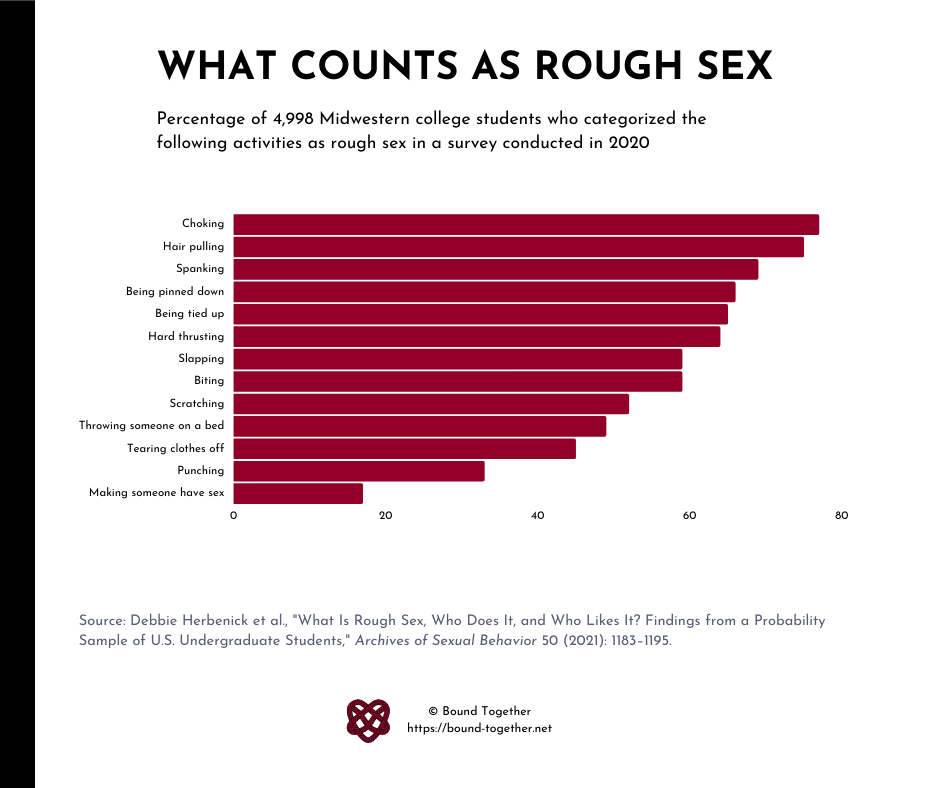
Spanking, hair pulling, slapping, spitting—these are just some of the activities that a lot of people consider to be part of rough sex. But these acts also fall squarely under the umbrella of BDSM. So is there a difference between rough sex and BDSM? If so, what is it? And if there isn’t, then why don’t more people simply call rough sex BDSM?
What is rough sex?
Despite the fact that nearly 80 percent of college students surveyed in one 2021 study said that they’ve had rough sex, there is little consensus on what it is. That said, a variety of studies have shown that people tend to categorize some actions this way more than others. For instance, the same study revealed that many people count spanking, hard thrusting, being pinned down, being tied up, and hair pulling as rough sex, which is consistent with past research. However, a number of activities that prior studies found were too extreme to count as rough sex made the cut in this study, including choking, slapping, and punching. Notably absent from the list of rough sex activities was anything involving an implement, except for rope or something else that could be used to tie someone up.
What is BDSM?
Strictly speaking, BDSM involves bondage and discipline, dominance and submission, and/or sadism and masochism. There’s more to it than the words that make up the abbreviation, though. According to Wikipedia, “given the wide range of practices, some of which may be engaged in by people who do not consider themselves to be practising BDSM, inclusion in the BDSM community or subculture often is said to depend on self-identification and shared experience.”
The idea of self-awareness is also reflected in Jay Wiseman’s definition of BDSM in his book SM 101: “the knowing use of psychological dominance and submission, and/or physical bondage, and/or pain, and/or related practices in a safe, legal, consensual manner in order for the participants to experience erotic arousal and/or personal growth.”
What is the difference?
Going by the definition of the BDSM abbreviation, it’s clear that the rough sex activities listed above count as BDSM. So what, then, is the difference? Both Wikipedia and Wiseman note that BDSM involves self-identification or awareness. A similar theme emerged when I asked on a BDSM subreddit what the difference is between rough sex and BDSM. Some people commented that there’s no difference other than awareness—or lack thereof—of BDSM jargon. Others noted that BDSM involves more in-depth research and knowledge about safety and best practices.
However, if the dividing line between rough sex and BDSM is based on awareness, then I would argue it’s a fairly blurry line. After all, a punch is a punch regardless of what you call it.
Does it matter?
According to one study, at least a third of Americans have engaged in spanking, and a decent percentage have done bondage and other impact. Combined with the high percentage of college students who report having had rough sex, this means that the majority of people engage in BDSM activities at least some of the time—whether they call it that or not.
So if people who have rough sex are in fact doing BDSM, why not say that? I don’t have a definitive answer to this, just some theories:
- Many people practicing rough sex may simply be unaware of BDSM and what it includes.
- “Rough sex” may sound more acceptable and mainstream, whereas “BDSM” connotes a deviant sexual lifestyle that involves things that people practicing rough sex consider to be foreign or more extreme.
- To some people, the unspoken dividing line between rough sex and BDSM may be the use of implements.
- Some people may associate BDSM with dungeons, leather bars, or other community-oriented aspects of BDSM that suggest a higher bar for entry than rough sex.
More importantly, does it really matter what these behaviors are called as long as the people doing them are having fun? Possibly, yes. Given the limited adoption of BDSM norms related to safety, consent, and negotiation within the vanilla world, it might be easier to broaden the public’s understanding of what falls under the BDSM umbrella instead. Perhaps then people would see that what they’re calling rough sex does count as BDSM, and they should educate themselves accordingly.
BDSM activities without consensuality is rough sex – where consensus has not been reached prior to engaging.